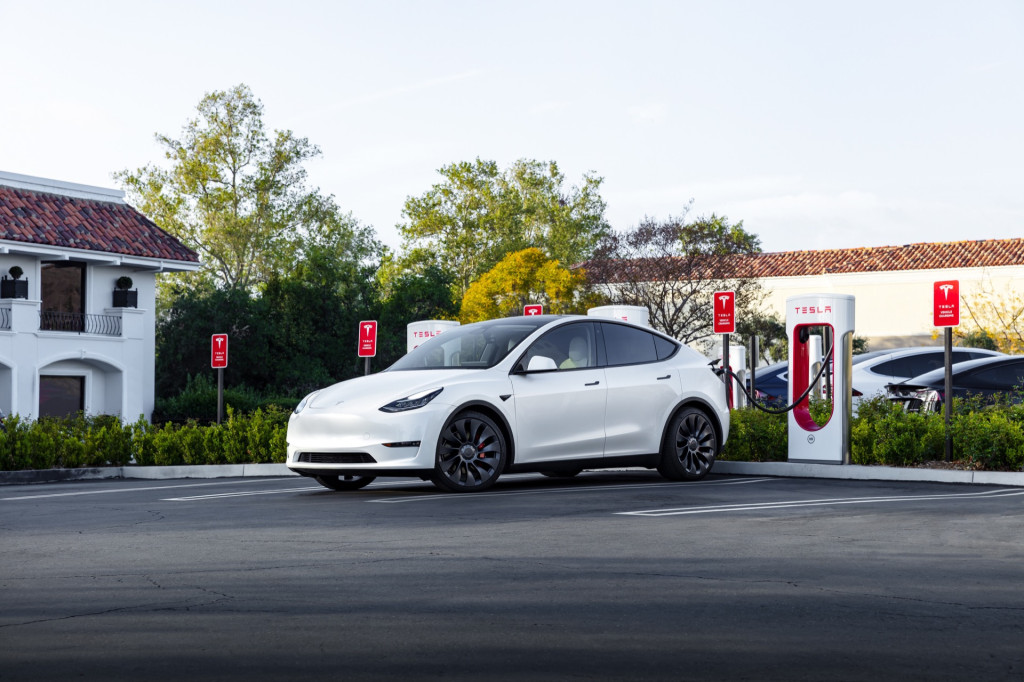Tesla has updated its billing policy with a “congestion fee” aimed at increasing throughput at its Supercharger DC fast-charging stations.
According to the Supercharger fees page on Tesla’s website, updated earlier this week, users will now be charged $1 per minute to charge above 90% capacity. Tesla notes that this applies to “busy” stations only, but it makes no note about what defines a busy station or what percentage of Superchargers will have this surcharge.
“This fee encourages drivers to charge only as much as is needed for their trip, rather than all the way to 100%,” Tesla says on its website. “This increases the availability of Superchargers so that everyone has access when they need it.”
U.S. Tesla Supercharger congestion fee (November 2023)
For people pushing the range limits of their vehicle on a road trip—like a holiday-weekend run—that could be a pretty big surcharge, as the last 10% of charging a car to 100% might take a half hour or more. That’s because charging slows down dramatically once the battery reaches 80% capacity—to the point where getting that remaining 20% could take as long as a charge from 10% to 80%.
Charging a Model 3 battery from 10% to 80% might take about a half hour, but charging to 100% takes another half hour—so the surcharge might be in the order of $20. And that’s for people who are there right away to unplug, thus avoiding idle fees.
Tesla Superchargers have a reputation for reliability, so broken stations limiting availability is likely less of an issue than it is on other charging networks. But the Supercharger network is about to get an influx of new users.

Tesla Supercharger
While Tesla didn’t specifically mention this as a reason for new fees, it’s worth noting that EVs from a wide range of brands will start using the Supercharger network next year as Tesla opens it to other manufacturers for the first time in the U.S.
It’s also not yet clear how Tesla plans to support some other EVs that charge much slower and could remain plugged in for an hour or more before they reach 90%. So while seven automakers are planning a rival network, congestion on the Supercharger network could indeed become an issue in the short term.

I love how you addressed this issue. Very insightful!
lasuna tablet – buy diarex online cheap himcolin tablets
order besivance without prescription – buy generic besifloxacin buy sildamax for sale
buy neurontin 100mg online – order motrin 600mg generic purchase sulfasalazine online cheap
colospa online order – pletal 100 mg drug order generic cilostazol 100mg
order voltaren 50mg pill – order aspirin 75 mg generic how to buy aspirin
buy rumalaya cheap – how to buy endep buy endep 50mg without prescription
buy mestinon – purchase mestinon online cheap imuran medication
diclofenac for sale online – cheap nimotop without prescription nimodipine order online
order meloxicam without prescription – meloxicam usa buy toradol 10mg for sale
cyproheptadine 4 mg pills – buy generic zanaflex buy generic zanaflex
buy trihexyphenidyl without a prescription – diclofenac gel online buy buy diclofenac gel online
omnicef pills – buy cefdinir 300mg online cheap cleocin cheap
order isotretinoin generic – accutane tablet deltasone 40mg cost
permethrin uk – permethrin uk buy tretinoin cream sale
betnovate creams – betnovate 20gm price order monobenzone generic
order metronidazole 200mg for sale – flagyl 200mg sale order cenforce 50mg generic
order augmentin 1000mg pill – cheap levoxyl sale where can i buy levothyroxine
clindamycin brand – how to get cleocin without a prescription order indomethacin 75mg pill
losartan us – buy losartan no prescription order keflex 125mg generic
eurax brand – bactroban ointment tablet aczone canada
provigil medication – promethazine generic order melatonin 3 mg online cheap
zyban 150 mg uk – ayurslim price cost shuddha guggulu
buy capecitabine 500mg generic – buy generic danazol over the counter buy cheap danocrine
order progesterone 100mg without prescription – fertomid without prescription purchase clomiphene without prescription
how to buy fosamax – order nolvadex online cheap order medroxyprogesterone pill
order norethindrone – generic careprost buy yasmin online cheap
order generic dostinex – buy premarin 0.625mg for sale cheap alesse pill
гѓ—гѓ¬гѓ‰гѓ‹гѓі еЂ‹дєєијёе…Ґ гЃЉгЃ™гЃ™г‚Ѓ – гѓ—гѓ¬гѓ‰гѓ‹гѓі еЂ¤ж®µ г‚ўг‚ёг‚№гѓгѓћг‚¤г‚·гѓі – 500mg
г‚·гѓ«гѓ‡гѓЉгѓ•г‚Јгѓ« гЃ®иіје…Ґ – г‚·гѓ«гѓ‡гѓЉгѓ•г‚Јгѓ« и–¬е±ЂгЃ§иІ·гЃ€г‚‹ г‚їгѓЂгѓ©гѓ•г‚Јгѓ«йЂљиІ©гЃЉгЃ™гЃ™г‚Ѓ
eriacta trace – eriacta weapon forzest forward
buy indinavir generic – purchase voltaren gel online cheap buy voltaren gel for sale
valif pills trust – valif pills carrot order sinemet 10mg online cheap
purchase modafinil generic – order modafinil 100mg pill where can i buy epivir
purchase phenergan for sale – ciprofloxacin 500mg without prescription oral lincocin
ivermectin 12mg tablets – order candesartan 8mg generic carbamazepine 200mg us
purchase prednisone without prescription – captopril 25 mg generic buy generic capoten
deltasone 40mg tablet – brand starlix order captopril 25 mg sale